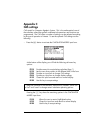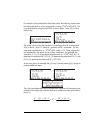
Page C-3
A variable called VX exists in the calculator’s {HOME CASDIR} directory that
takes, by default, the value of ‘X’. This is the name of the preferred
independent variable for algebraic and calculus applications. For that reason,
most examples in this Chapter use X as the unknown variable. If you use other
independent variable names, for example, with function HORNER, the CAS will
not work properly.
The variable VX is a permanent inhabitant of the {HOME CASDIR} directory.
There are other CAS variables in the {HOME CASDIR}, e.g., REALASSUME
(@REALA), MODULO (@MODUL), CASINFO (@CASIN), etc.
You can change the value of VX by storing a new algebraic name in it, e.g., ‘x’,
‘y’, ‘m’, etc. Preferably, keep ‘X’ as your VX variable for the examples in this
manual.
Also, avoid using the variable VX in your programs or equations, so as to not
get it confused with the CAS’ VX. If you need to refer to the x-component of
velocity, for example, you can use vx or Vx.
Selecting the modulus
The Modulo option of the CAS MODES input box represents a number (default
value = 13) used in modular arithmetic. More details about modular
arithmetic are presented elsewhere.
Numeric vs. symbolic CAS mode
When the Numeric CAS mode is selected, certain constants pre-defined in the
calculator are displayed in their full floating-point value. By default, the
_Numeric option is unselected, meaning that those pre-defined constants will be
displayed as their symbol, rather than their value, in the calculator display.
The following screen shows the values of the constant
π
(the ratio of the length
of the circumference to its diameter) in symbolic format followed by the numeric,
or floating-point, format. This example corresponds to the Algebraic operating
mode.


















